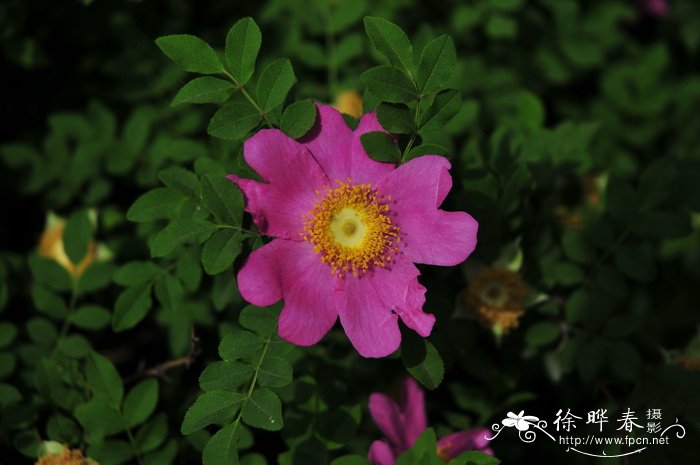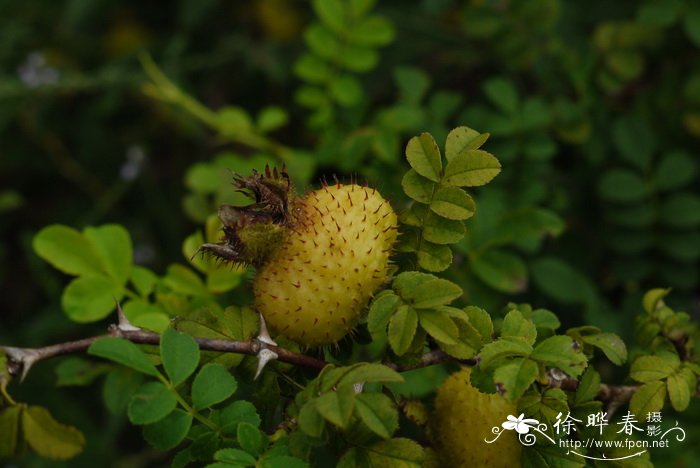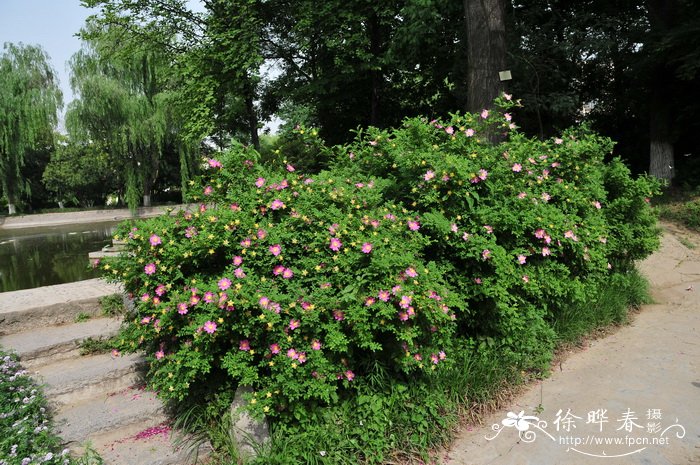剿丝花Rosa roxburghii
中文名(Chinese Name):剿丝花
学名(Scientific Name):Rosa roxburghii Tratt.
英文名(English Common Name):chestnut rose
别名(Chinese Common Name):刺梨
异名(Synonym):Juzepczukia roxburghii (Tratt.) Chrshan. Rosa microphylla var. glabra Regel Rosa microphylla Desfontaines: Roxb. apud Lind. Platyrhodon microphyllum (Roxb. ex Lindl.) Hurst Rosa roxbourgii Tratt. Saintpierrea microphylla (Roxb. ex Lindl.) Germ. Rosa roxburghii var. plena Rehder Rosa roxburghii 'Plena'
科属(Family & Genus):蔷薇科(Rosaceae)蔷薇属
形态特征(Description):开展灌木,高1-2.5米;树皮灰褐色,成片状剥落;小枝圆柱形,斜向上升,有基部稍扁而成对皮刺。小叶9-15,连叶柄长5-11厘米,小叶片椭圆形或长圆形,稀倒卵形,长1-2厘米,宽6-12毫米,先端急尖或圆钝,基部宽楔形,边缘有细锐锯齿,两面无毛,下面叶脉突起,网脉明显,叶轴和叶柄有散生小皮刺;托叶大部贴生于叶柄,离生部分呈钻形,边缘有腺毛。花单生或2-3朵,生于短枝顶端;花直径5-6厘米;花梗短;小苞片2-3枚,卵形,边缘有腺毛;萼片通常宽卵形,先端渐尖,有羽状裂片,内面密被绒毛,外面密被针刺;花瓣重瓣至半重瓣,淡红色或粉红色,微香,倒卵形,外轮花瓣大,内轮较小;雄蕊多数着生在杯状萼筒边缘;心皮多数,着生在花托底部;花柱离生,被毛,不外伸,短于雄蕊。果扁球形,直径3-4厘米,绿红色,外面密生针刺;萼片宿存,直立。花期5-7月,果期8-10月。
分布(Distribution):产陕西、甘肃、江西、安徽、浙江、福建、湖南、湖北、四川、云南、贵州、西藏等省区,均有野生或栽培。也见于日本。
用途(Use):果实味甜酸,含大量维生素,可供食用及药用,还可作为熬糖酿酒的原料,根煮水治痢疾。花朵美丽,栽培供观赏用。枝干多刺可以为绿篱。
引自中国植物志英文版:FOC Vol. 9 Page 381
Rosa roxburghii Trattinnick, Ros. Monogr. 2: 233. 1823.
缫丝花 sao si hua| Rosaceae | Rosa
Rosa microphylla Desfontaines var. glabra Regel.
Shrubs diffuse, 1–2.5 m tall. Bark gray-brown; branchlets ascending-spreading, purple-brown, terete; prickles paired at nodes, mostly straight, to 5 mm, somewhat flat, abruptly narrowing to broad base. Leaves including petiole 5–11 cm; stipules mostly adnate to petiole, free parts subulate, margin glandular-pubescent; rachis and petioles with scattered small prickles; leaflets 9–15, elliptic or oblong, rarely obovate, 1–2 × 0.6–1.2 cm, glabrous, abaxially with prominent veins, conspicuously reticulate, base broadly cuneate, margin acutely simply serrulate, apex acute or rounded-obtuse. Flowers solitary, or 2 or 3 and fasciculate apically on branches, 4–6 cm in diam.; pedicel short; bracts 2 or 3, small, margin glandular-pubescent. Hypanthium depressed-globose, densely bristly. Sepals 5, usually broadly ovate, abaxially densely prickly, adaxially tomentose, pinnately lobed, apex acuminate. Petals 5, slightly fragrant, pink to rose-purple or reddish, obovate. Carpels on projected torus at base of hypanthium; styles free, not exserted, shorter than stamens, pubescent. Hip green-red, depressed-globose, 1.5–2 cm in diam., densely prickly, with persistent, erect sepals. Fl. Mar–Jul, fr. Aug–Oct.
Mountain forests, thickets, slopes, stream sides, also cultivated; 500--1400 m. Anhui, Fujian, S Gansu, Guangxi, Guizhou, Hubei, Hunan, Jiangxi, S Shaanxi, Sichuan, Xizang, Yunnan, Zhejiang [Japan].
Two forms may be recognized: f. roxburghii, which has double or semi-double, reddish or pink flowers 5–6 cm in diam., and f. normalis Rehder & E. H. Wilson (in Sargent, Pl. Wilson. 2: 318. 1915), which has simple, pink flowers 4–6 cm in diam. The specific epithet was spelled “roxbourgii” in the protologue.
The edible fruit are very rich in vitamins and have a sweet, sour taste; they are used medicinally and to ferment wine. The roots are also used medicinally. The species is also cultivated for ornament, for its showy flowers, or as a hedge because of its abundant prickles.



(责任编辑:徐晔春)
学名(Scientific Name):Rosa roxburghii Tratt.
英文名(English Common Name):chestnut rose
别名(Chinese Common Name):刺梨
异名(Synonym):Juzepczukia roxburghii (Tratt.) Chrshan. Rosa microphylla var. glabra Regel Rosa microphylla Desfontaines: Roxb. apud Lind. Platyrhodon microphyllum (Roxb. ex Lindl.) Hurst Rosa roxbourgii Tratt. Saintpierrea microphylla (Roxb. ex Lindl.) Germ. Rosa roxburghii var. plena Rehder Rosa roxburghii 'Plena'
科属(Family & Genus):蔷薇科(Rosaceae)蔷薇属
形态特征(Description):开展灌木,高1-2.5米;树皮灰褐色,成片状剥落;小枝圆柱形,斜向上升,有基部稍扁而成对皮刺。小叶9-15,连叶柄长5-11厘米,小叶片椭圆形或长圆形,稀倒卵形,长1-2厘米,宽6-12毫米,先端急尖或圆钝,基部宽楔形,边缘有细锐锯齿,两面无毛,下面叶脉突起,网脉明显,叶轴和叶柄有散生小皮刺;托叶大部贴生于叶柄,离生部分呈钻形,边缘有腺毛。花单生或2-3朵,生于短枝顶端;花直径5-6厘米;花梗短;小苞片2-3枚,卵形,边缘有腺毛;萼片通常宽卵形,先端渐尖,有羽状裂片,内面密被绒毛,外面密被针刺;花瓣重瓣至半重瓣,淡红色或粉红色,微香,倒卵形,外轮花瓣大,内轮较小;雄蕊多数着生在杯状萼筒边缘;心皮多数,着生在花托底部;花柱离生,被毛,不外伸,短于雄蕊。果扁球形,直径3-4厘米,绿红色,外面密生针刺;萼片宿存,直立。花期5-7月,果期8-10月。
分布(Distribution):产陕西、甘肃、江西、安徽、浙江、福建、湖南、湖北、四川、云南、贵州、西藏等省区,均有野生或栽培。也见于日本。
用途(Use):果实味甜酸,含大量维生素,可供食用及药用,还可作为熬糖酿酒的原料,根煮水治痢疾。花朵美丽,栽培供观赏用。枝干多刺可以为绿篱。
引自中国植物志英文版:FOC Vol. 9 Page 381
Rosa roxburghii Trattinnick, Ros. Monogr. 2: 233. 1823.
缫丝花 sao si hua| Rosaceae | Rosa
Rosa microphylla Desfontaines var. glabra Regel.
Shrubs diffuse, 1–2.5 m tall. Bark gray-brown; branchlets ascending-spreading, purple-brown, terete; prickles paired at nodes, mostly straight, to 5 mm, somewhat flat, abruptly narrowing to broad base. Leaves including petiole 5–11 cm; stipules mostly adnate to petiole, free parts subulate, margin glandular-pubescent; rachis and petioles with scattered small prickles; leaflets 9–15, elliptic or oblong, rarely obovate, 1–2 × 0.6–1.2 cm, glabrous, abaxially with prominent veins, conspicuously reticulate, base broadly cuneate, margin acutely simply serrulate, apex acute or rounded-obtuse. Flowers solitary, or 2 or 3 and fasciculate apically on branches, 4–6 cm in diam.; pedicel short; bracts 2 or 3, small, margin glandular-pubescent. Hypanthium depressed-globose, densely bristly. Sepals 5, usually broadly ovate, abaxially densely prickly, adaxially tomentose, pinnately lobed, apex acuminate. Petals 5, slightly fragrant, pink to rose-purple or reddish, obovate. Carpels on projected torus at base of hypanthium; styles free, not exserted, shorter than stamens, pubescent. Hip green-red, depressed-globose, 1.5–2 cm in diam., densely prickly, with persistent, erect sepals. Fl. Mar–Jul, fr. Aug–Oct.
Mountain forests, thickets, slopes, stream sides, also cultivated; 500--1400 m. Anhui, Fujian, S Gansu, Guangxi, Guizhou, Hubei, Hunan, Jiangxi, S Shaanxi, Sichuan, Xizang, Yunnan, Zhejiang [Japan].
Two forms may be recognized: f. roxburghii, which has double or semi-double, reddish or pink flowers 5–6 cm in diam., and f. normalis Rehder & E. H. Wilson (in Sargent, Pl. Wilson. 2: 318. 1915), which has simple, pink flowers 4–6 cm in diam. The specific epithet was spelled “roxbourgii” in the protologue.
The edible fruit are very rich in vitamins and have a sweet, sour taste; they are used medicinally and to ferment wine. The roots are also used medicinally. The species is also cultivated for ornament, for its showy flowers, or as a hedge because of its abundant prickles.
(责任编辑:徐晔春)
踩一下[0]

顶一下[4]